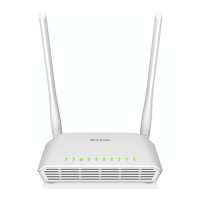105D-Link DSL-226 User Manual
Appendix A - Wireless Basics
Channel and Width Selection
Auto channel is recommended when conguring channels for the wireless network. However, you can select a particular
channel to avoid congested channels. For 2.4 GHz, channels 1, 6, and 11 do not overlap, which reduces the possibility of
interference and increases reliability. Channel bonding allows 20 MHz to bond together to increase the channel width to
40, doubling the data transmission capacity of the wireless network. For 802.11n, you can select 20/40 MHz Channel Width.
In general, higher channel width should be used to meet performance requirement, for example, applications that provide
location-based services and content streaming. On the other hand, lower channel width should be used for deployment with
high density of AP devices and to accommodate mobile devices with older standards.
Signal Strength
Even though you may have chosen the least congested channel, connection reliability requires strong signals. Factors such as
the number of walls or obstacles (especially metal objects) between your access point and client PC, the distance between the
PC and the AP, and the position of the AP or router as well as your PC aect the strength of a wireless signal.
The signal strength can be obtained from the built-in utility of the desktop or mobile devices. For example, the Windows
wireless connection icon uses the number of bars to indicate the signal strength of the wireless network. On an Android phone
there is also the wireless connection icon displaying signal strength for wireless networks in range (go to Settings > Network &
Internet > Internet).
Encryption
Don’t let your next-door neighbors or intruders connect to your wireless network. Encrypt your wireless network by turning on
the latest encryption on the router. Create a long passphrase with random characters and change it regularly.

